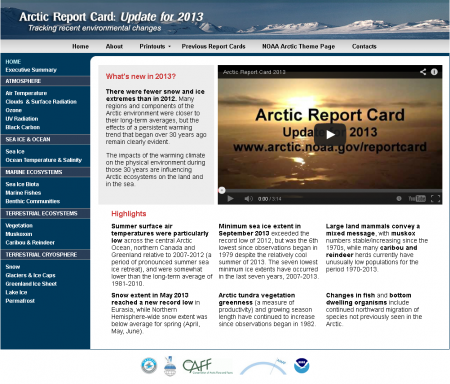
The 2013 Arctic Report Card was released on 12 December 2013 during a press conference led by Dr. Martin Jeffries, Principal Editor of the Arctic Report Card and science advisor to the U.S. Arctic Research Commission. This annual update from the National Oceanic and Atmospheric Administration (NOAA) reports on key indicators and components being tracked in the Arctic. The 2013 update contains 18 essays by 147 authors from 14 countries describing the state of the Arctic environmental system.
The 2013 update revealed that there were fewer snow and ice extremes than in the previous year. Many regions and components of the Arctic environment were closer to their long-term averages, but the effects of a persistent warming trend that began over 30 years ago remain clearly evident. Relatively cool air temperatures in summer 2013 across the central Arctic Ocean, Greenland, and northern Canada facilitated an increase in the summer sea ice extent and a decrease in the extent and duration of melting at the surface of the Greenland ice sheet. In contrast, the summer of 2013 was one of the warmest on record in Alaska, where new record high temperatures were set at some permafrost observatories. Fairbanks, near the center of the state, experienced a record 36 days with temperatures of 27°C or higher. Overall, the impacts of the warming climate on the physical environment continue to influence Arctic ecosystems on the land and in the sea.
Highlights from the 2013 update include
- Summer surface air temperatures were particularly low across the central Arctic Ocean, northern Canada and Greenland relative to 2007-2012.
- Snow extent in May 2013 reached a new record low in Eurasia, while snow extent was below average for spring across the Northern Hemisphere.
- Minimum sea ice extent in September 2013 exceeded the record low of 2012, but was still the 6th lowest since observations began in 1979 despite the relatively cool summer of 2013.
- Arctic tundra vegetation greenness (a measure of productivity) and growing season length have continued to increase since observations began in 1982.
- Large land mammals convey a mixed message, with muskox numbers stable/increasing since the 1970s, while many caribou and reindeer herds currently have unusually low populations for the period 1970-2013.
- Changes in marine fish and bottom dwelling organisms include continued northward migration of species not previously seen in the Arctic.
The Arctic Report Card is supported by the Arctic Research Program in the NOAA Climate Program Office. The preparation of Arctic Report Card 2013 was directed by a U.S. inter-agency editorial team with representatives from NOAA, the Cold Regions Research and Engineering Laboratory and the U.S. Arctic Research Commission. Independent peer-review of the Report Card was facilitated by the Arctic Monitoring and Assessment Program.
For more information on the origin and history of the Arctic Report Card, see "The Arctic Report Card: Past and Present" in Witness the Arctic - Winter 2013.
The 2013 Arctic Report Card, a link to a YouTube video, and previous report cards, are available on the NOAA website.
For more information regarding the Arctic Report Card, please contact Monica Allen, NOAA Communications and NOAA Research, (monica.allen [at] noaa.gov) or phone: 301-734-1123.
Many thanks to Martin Jeffries and Jackie Richter-Menge for their review and contributions to this article.
References
Jeffries, M.O., J.A. Richter-Menge, and J.E. Overland, Eds., 2013: Arctic Report Card 2013.
